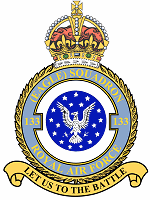No. 133 Squadron RAF
| No. 133 (Eagle) Squadron RAF | |
|---|---|
|
Official badge of No. 133 squadron RAF | |
| Active |
1 March 1918 - 4 July 1918 1 August 1941 – 29 September 1942 |
| Country |
|
| Allegiance |
|
| Branch |
|
| Nickname(s) | Eagle |
| Motto(s) | Let us to the battle |
| Insignia | |
| Squadron Badge heraldry | On a hurt a semée of mullets, an eagle deployed |
| Squadron Codes | MD (July 1941 - September 1942) |
133 Squadron RAF was one of the famous Eagle squadrons formed from American volunteers serving with the Royal Air Force (RAF) during the Second World War.
History
133 Squadron was first formed in 1918 at RAF Ternhill. It was a training unit for the Handley Page O/400, flying the Royal Aircraft Factory F.E.2, that was expected to move to France, but was disbanded on 4 July 1918. Various attempts to reform as both a bomber and fighter squadron were all abandoned as the end of the First World War approached.
It was reformed at RAF Coltishall in July 1941 as the third of the Eagle squadrons, equipped with Hawker Hurricane IIB fighters. It transferred to RAF Duxford in August, and by October was at RAF Eglinton, County Londonderry in Northern Ireland, where it was equipped with Supermarine Spitfire IIAs. It then transferred back to the south-east England including time at RAF Biggin Hill. The squadron ran fighter sweeps over France until September 1942 when it was transferred to the USAAF and became the 336th Fighter Squadron of the 4th Fighter Group.
Roland Wolfe's crash in Inishowen
In November 1941, while on patrol from RAF Eglinton in Northern Ireland, Roland 'Bud' Wolfe bailed out over the neutral Republic of Ireland. Patrolling near the Inishowen peninsula, Wolfe's coolant overheated. As his Spitfire began to lose altitude, he bailed out. Wolfe landed around Inishowen, in County Donegal and his Spitfire crashed in the heather covered area of Moneydarragh, Gleneely.
Wolfe was arrested and sent to Curragh detention prison, where he spent two years. He was then released and went on to serve the 'Eagles' once again. On 28 June 2011, his Spitfire was recovered by a team led by aviation historian Johnny McNee. The recovery was filmed for documentary purposes by the BBC.
Aircraft operated
- 1918 - Royal Aircraft Factory FE.2b
- 1941 - Hawker Hurricance IIB
- 1941 - Supermarine Spitfire IIB
- 1942 - Supermarine Spitfire VA and VB
- 1942 - Supermarine Spitfire IX
Fiction
In the 2005 episode of Doctor Who, "The Empty Child", Jack Harkness, from the 51st century, is posing as a volunteer in the squadron during 1941.
References
Notes
- ↑ Halley 1988, p. 207.
Bibliography
- Caine, Philip D. American Pilots in the RAF: The WWII Eagle Squadrons. Brassey's, 1993. ISBN 0-02-881070-8.
- Childers, James Saxon. War Eagles: The Story of the Eagle Squadron. Windmill Press, 1943.
- Republished by Eagle Publishing in 1983, ISBN 0-941624-71-4. Same as the 1943 edition, except it has an epilogue of the members in 1982.
- Halley, James J. The Squadrons of the Royal Air Force & Commonwealth, 1918-1988. Tonbridge, Kent, UK: Air-Britain (Historians) Ltd., 1988. ISBN 0-85130-164-9.
- Haughland, Vern. The Eagle Squadrons: Yanks in the RAF, 1940-1942. Ziff-Davis Flying Books, 1979.
- Republished by TAB Books in 1992, ISBN 0-8306-2146-6, with all the photos different from the 1st edition.
- Haughland, Vern. The Eagles' War: The Saga of the Eagle Squadron Pilots, 1940-1945. Jason Aronson, Inc., 1982. ISBN 0-87668-495-9.
- Republished by TAB Books in 1992, ISBN 0-8306-2145-8, with all the photos different from the 1st edition.
- Holmes, Tony. American Eagles: American Volunteers in the R.A.F., 1937-1943. Classic Publications, 2001. ISBN 1-903223-16-4.
- Jefford, Wing Commander C.G. MBE, BA, RAF (Retd.). RAF Squadrons, A Comprehensive Record of the Movement and Equipment of all RAF Squadrons and their Antecedents since 1912. Shrewsbury, UK: Airlife Publishing, 1998 (Second edition 2001). ISBN 978-1-84037-141-3.
- Rawlings, John D.R. Fighter Squadrons of the RAF and their Aircraft. London: Macdonald and Jane's (Publishers) Ltd., 1969 (new edition 1976, reprinted 1978). ISBN 0-354-01028-X.
External links
- 133 Squadron history
- RAF Eagle Squadron (historic video)
- 4th Fighter Group WWII Official WWII Association Website

